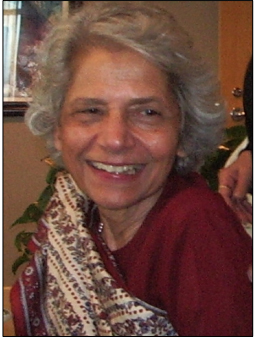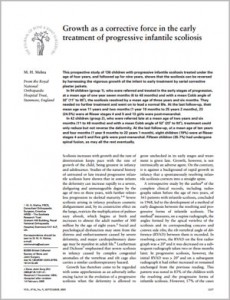- Home
- Infantile Scoliosis Outreach Program
- About Us
- Min H. Mehta, M.D., F.R.C.S
Min H. Mehta, M.D., F.R.C.S
 “From the age of six, I always knew I wanted to be a doctor. That is true; it has never changed” says Dr. Min Mehta about her life’s work. “Miss” Mehta, as she is respectfully called by her British colleagues, is the world’s foremost expert on infantile scoliosis.
“From the age of six, I always knew I wanted to be a doctor. That is true; it has never changed” says Dr. Min Mehta about her life’s work. “Miss” Mehta, as she is respectfully called by her British colleagues, is the world’s foremost expert on infantile scoliosis.
Miss Mehta tells the story of discovering her own adolescent scoliotic curve. “At about age 11 ½,” she recounts, “my parents and other adults began to tell me to ‘sit up straight.’ At last a family friend–a nurse–said, ‘the child can’t sit up straight – she has a scoliosis.’” And, Dr. Mehta observes, the process of detecting scoliosis hasn’t changed much over the years.
Dr. Mehta attended medical school in her native Calcutta, India. During the course of her training, she discovered that she was interested in surgery, and had a natural aptitude for it. After completing a three-year surgical training program in Calcutta, she moved to Britain to continue her studies and gain further qualifications. There, she took her Fellow Royal College of Surgeons (FRCS) examination, which is necessary to become a surgical specialist, intending at that time to practice neurosurgery.
Miss Mehta was required to study orthopaedics as well, to pass her examinations. She had the good fortune to work with Mr. Wiles and Mr. Batchelor, two of the foremost orthopaedic surgeons of the time at London teaching hospitals. As a result, she became so intrigued by orthopaedics that she changed her specialty focus.
| Growth as a corrective force in the early treatment of progressive infantile scoliosis  by Min H. Mehta, M.D., F.R.C.S.Published in The Journal of Bone and Joint Surgery (Br) Click here to read more |
Quickly, Dr. Mehta began to appreciate the challenge she had taken on. “It will be tough because you’re a woman,” one of her teachers cautioned. “But you must go for it, because you are good.” It was the 1950s. Miss Mehta, because of her gender, faced enormous difficulties securing interviews for the positions she needed to advance her career. There were few female surgeons practicing in Britain at the time, and the
establishment was eager to maintain status quo. She made dozens of applications and received no calls to interview. Eventually, Miss Mehta received an application form that did not ask the formidable “gender” question. She returned it and, due to her impressive credentials, was invited immediately to interview. Although they were surprised to see a woman, it happened that none of the other three applicants for the post showed up for their appointments. She landed the position.
In 1968, Miss Mehta was the second woman in history to be awarded the prestigious Robert Jones Prize and Gold Medal in Orthopaedics for her work on “A Study of Infantile Scoliosis.” By then, she had already discovered the Rib Vertebral Angle Degree (RVAD), which is the standard and routinely accepted measurement approach employed today to determine whether a scoliotic curve is progressive. She had also come to understand the benefits of early treatment of progressive infantile scoliosis. However, the journals would not publish this work because they felt there was not enough evidence.
A year later in 1969, still struggling to climb the London surgical ladder due to her gender, Dr. Mehta returned to India. She worked in major teaching hospitals in New Delhi and Calcutta for five years. Her paper on the RVAD was published in the Journal of Bone and Joint Surgery in 1972, while she was practicing in India.
In 1974, Miss Mehta moved back to England, stepping into a hard-earned and well-deserved position:
Senior Lecturer in Clinical Research at the Institute of Orthopaedics, University of London. She also served as an Honorary Consultant in Scoliosis at the Royal National Orthopaedic Hospital during this time, until 1992 (this is the British equivalent to the American “Chief of Surgery” position). Since then, Dr. Mehta has continued her research on non-surgical methods of treatment for infantile, congenital and adolescent idiopathic scoliosis at the Royal National Orthopaedic Hospital.
Although Dr. Mehta has “officially” reached the British obligatory age of retirement, she continues to passionately pursue her life’s work. She continues to see private patients. The paper, “Growth as a corrective force in the early treatment of progressive infantile scoliosis,” published in September 2005 in the British Editorial Society of Bone and Joint Surgery, chronicles years of infantile scoliosis case studies.
Now, Dr. Mehta knows, her challenge is to spread the message about her findings and methods; to educate as many doctors and to help as many children as possible. “It is easy to learn how to apply a plaster jacket,” she says about the casting technique she has perfected. “The trick is to learn to look critically at each child and understand how it can be assisted. The earlier you treat children, the greater the chance of making them straight. But all children are different: their build, tissues, size, and shape vary. Some can be straightened completely and, for some, it may be too late. They are like little drooping flowers. Braces don’t work, and the flower will just flop back to the way it was. It needs to get is own sap, so it can hold itself straight.”
“I intend to keep on and on, to see that these messages are delivered,” Miss Mehta insists. And the Infantile Scoliosis Outreach Program is determined to help her achieve that goal.


